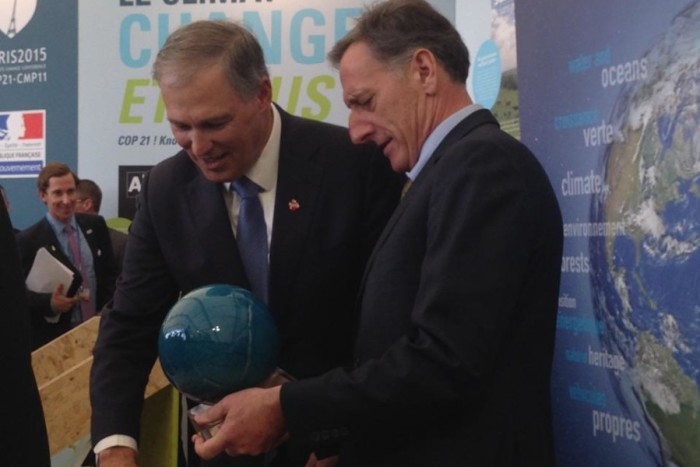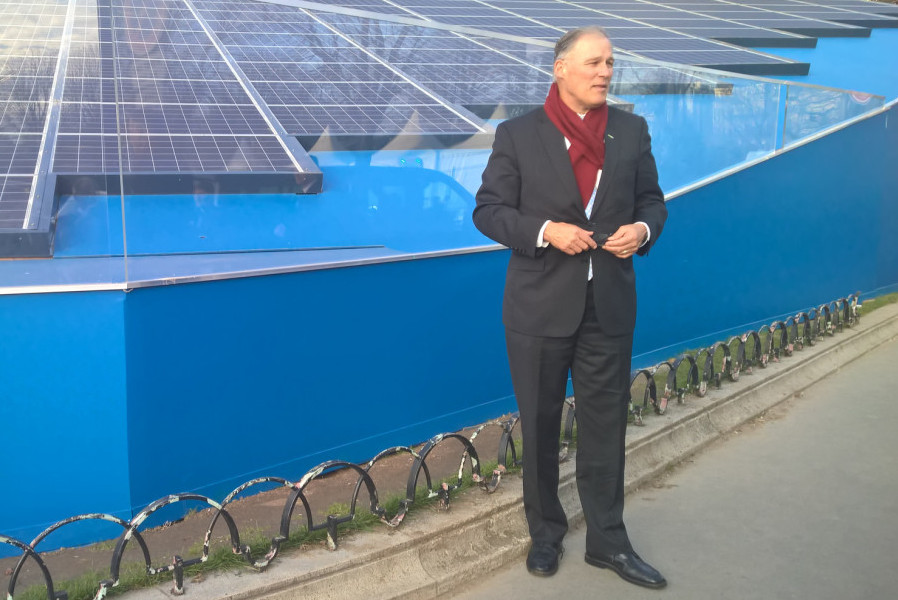
Gov. Jay Inslee, who returns today from the Paris Climate Change Conference, says a plan developing among Canadian provinces could open a door for Washington companies to reduce carbon emissions.
The provinces of British Columbia, Alberta, Ontario and Quebec have set or are setting up programs to cap and reduce carbon emissions from polluting industries.
In a telephone press conference from Paris Tuesday, Inslee said his administration is exploring allowing Washington’s smokestack industries to buy emissions credits from their Canadian counterparts to ease this state’s transition to a carbon emissions cap system.
At the Paris conference, Washington also signed agreements with France and Chile to share climate change research, Inslee said.
The Inslee administration has been exploring since September how to reduce the carbon emissions of at least 35 of the state’s biggest polluters thorough executive action, with a draft plan due by the end of this month. A final plan probably won’t be nailed down until mid-2016 at the earliest.
Washington’s potential arrangement with the Canadian provinces is a model of what is called a “cap-and-trade” system.
What Inslee is exploring is this: the state’s 35 biggest polluters — including Seattle-based Nucor Steel, Ash Grove Cement Company and Puget Sound Energy — would each be legally forbidden from emitting above specific volumes of carbon pollution each.
These 35 companies account for 59 percent of the state’s carbon emissions, according to the Washington Department of Ecology. The companies produce at least 100,000 metric tons of carbon apiece each year, including five oil refineries, nine power plants, three aluminum plants and five methane-producing landfills. The list of companies does not include dozens of fuel supply operations and smaller food processing plants that have been named on the the state’s earlier other lists of pollution targets.
Under a cap-and-trade system, if one of these companies cannot bring its emissions within the targeted volumes, it can buy the unused amounts of allowed emissions from another facility that on the list to compensate of the extra pollution. This is essentially a zero sum game. One form of cap-and-trade is to have several states and provinces get together and agree to let any over-polluting buy credits from the under-polluting facilities — spreading the zero sum game among a number of states and provinces.
So if Washington makes an agreement with one or more Canadian provinces, a plant in this state could conceivably buy extra volumes of allowed carbon emissions from facilities in British Columbia, Alberta, Ontario or Quebec.
On Tuesday, Inslee cautioned that it won’t be known if he will recommend going this route until his administration’s draft plan is unveiled later this month.
Inslee has been in Paris for the 21st annual United Nations conference on climate change issues, known as COP21, with more than 180 nations aiming to sign an agreement to keep global warming to a minimum, with a target of two degrees Celsius.
Inslee said cities, states and provinces are often more nimble than their parent nations in trying and setting up ways to combat global warming.
“There’s great momentum for this,” he said.
Heavily populated India and China were not in line to sign the COP21 agreement as of Tuesday. But Inslee said several Chinese provinces have begun efforts to reduce carbon emissions.
“People can’t breathe in Beijing,” Inslee said.
Inslee has pledged to pass laws that would encourage carbon reduction efforts in Washington, but his efforts have stalled after heavy opposition from major business interests and legislative Republicans, who argue that such measures will increase the costs of doing business and threaten jobs. The GOP-controlled Senate has been an unsurmountable obstacle to Inslee so far.
This move is Inslee trying to sidestep opposition to his climate agenda from Republicans, and reluctance from his fellow Democrats. In the 2015 legislative session, Senate Republicans vehemently objected to Inslee’s proposed carbon emissions tax.
In July, Inslee announced that he would install a carbon cap on major polluters instead — launching the Department of Ecology’s current effort. Critics say the move stretches the limits of executive power. Inslee insists that he has the authority under the Washington Clean Air Act and a 2008 law that set a goal of reducing the state’s greenhouse emissions to 1990 levels by 2020, with further trimming later.
So far, no progress has been made toward those goals and the state appears to be on course to miss all the targets, especially with population growth.
Global warming has already shrunk Cascade Mountains’ glaciers and snow packs feeding streams and rivers used by migrating fish and for irrigated farming. Carbon emissions have also been linked to the increasing acidity of seawater, which harms shellfish, a $270 million annual industry for the state.
A signature-gathering campaign is underway to put a carbon tax on the ballot. If passed, Initiative 732 would create a $25 per ton tax on fossil fuels, cut the state sales tax by one cent, provide a $1,500 tax credit to 400,000 poor working families, plus reduce the business-and-occupation tax for manufacturers.



Great article. I’ll note there is one oversimplification of the role of emissions trading under a carbon cap. The “Cap” is what creates the emissions reductions, and the “Trade”, zero sum as it may be, makes up the system by which capped entities comply with regulation.
“Under a cap-and-trade system, if one of these companies cannot bring its emissions within the targeted volumes, it can buy the unused amounts of allowed emissions from another facility that on the list to compensate of the extra pollution. This is essentially a zero sum game.”
For example, if emissions in a program’s base year were 100 million tonnes, and the regulation had a cap that declined by 5% per year, next year’s emissions can only be 95 million tonnes. Those 95 million tonnes are issued as “carbon allowances” and distributed to emitters, (usually a mix of free allowance and auctioned allowances at the start, progressing to full auctioning.) The emitters then buy/sell/trade the carbon allowances, with early movers on efficiency having to buy fewer, and slower movers having to buy more. So within the trading system, there is some element of back and forth, but at the end of the day everyone must possess enough carbon allowances to cover every single tonne of CO2e emissions they make that calendar year. Because there can only be 95 million tonnes of CO2 emissions in the system, there you have your emissions reduction.